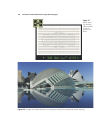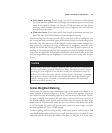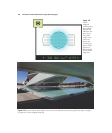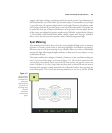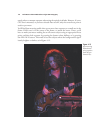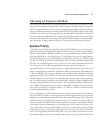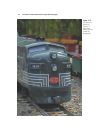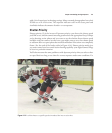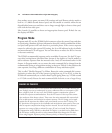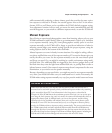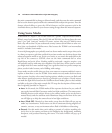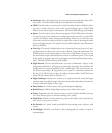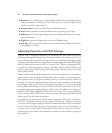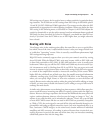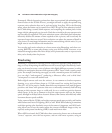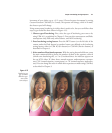
shot outdoor soccer games on sunny Fall evenings and used Shutter-priority mode to
lock in a 1/1,000th second shutter speed, and was unable to continue when the sun
dipped behind some trees and there was no longer enough light to shoot at that speed,
even with the lens wide open.
Like A mode, it’s possible to choose an inappropriate shutter speed. If that’s the case,
the displays will flash.
Program Mode
Program mode (P) uses the D7000’s built-in smarts to select the correct f/stop and shut-
ter speed using a database of picture information that tells it which combination of shut-
ter speed and aperture will work best for a particular photo. If the correct exposure
cannot be achieved at the current ISO setting, the Lo or Hi indicator in the viewfinder
and monochrome LCD will appear. You can then boost or reduce the ISO to increase
or decrease sensitivity.
The D7000’s recommended exposure can be overridden if you want. Use the EV (expo-
sure value) setting feature (described later, because it also applies to S and A modes) to
add or subtract exposure from the metered value. And, as I mentioned earlier in this
chapter, in Program mode you can rotate the main command dial to change from the
recommended setting to an equivalent setting (as shown in Table 6.1) that produces the
same exposure, but using a different combination of f/stop and shutter speed.
This is called “Flexible Program” by Nikon. Rotate the main command dial counter-
clockwise to reduce the size of the aperture (going from, say, f/4 to f/5.6), so that the
D7000 will automatically use a slower shutter speed (going from, say, 1/250th second
to 1/125th second). Rotate the main command dial clockwise to use a larger f/stop,
David Busch’s Nikon D7000 Guide to Digital SLR Photography114
MAKING EV CHANGES
Sometimes you’ll want more or less exposure than indicated by the D7000’s metering sys-
tem. Perhaps you want to underexpose to create a silhouette effect, or overexpose to pro-
duce a high key look. It’s easy to use the D7000’s exposure compensation system to
override the exposure recommendations. Press the EV button on the top of the camera
(just southeast of the shutter release). Then rotate the main command dial counterclock-
wise to add exposure, and clockwise to subtract exposure. The EV change you’ve made
remains for the exposures that follow, until you manually zero out the EV setting. The
EV plus/minus icon appears in the viewfinder and monochrome status panel to warn you
that an exposure compensation change has been entered. You can increase or decrease
exposure over a range of plus or minus five stops. (If you’ve activated Easy Exposure
Compensation using CSM #b3, as described in Chapter 9, you don’t have to hold down
the EV button; rotating the main or sub-command dials alone changes the EV value
when using Program, Aperture-priority, Shutter-priority, or Manual exposure modes.)



